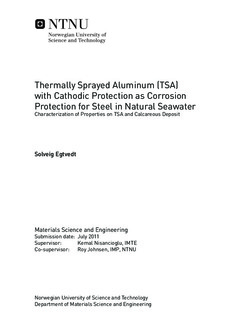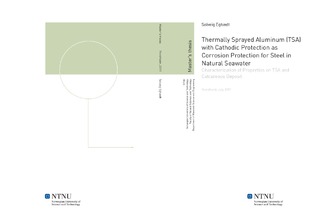| dc.description.abstract | Cathodic protection is an effective corrosion protection for structures submerged in seawater. In addition to applying the current need to lower the metal below the protection potential, a resulting increase in interfacial pH leads to precipitation of calcareous deposit. This deposited layer act as a barrier against oxygen diffusion on the surface, hence lowering the current demand of the structure. However, this layer will also hinder the thermal conductivity, and is therefore unwanted at the surface of heat exchangers.There are several factors influencing the precipitation of calcareous deposit. This includes potential, current, pH, seawater chemistry, flow rate etc. These factors have been thoroughly investigated for many years, but mostly with steel as substrate material. Specimens of steel coated with thermal sprayed aluminum (AlMg5) and aluminum plates of alloys AA5082, AA1050 and Al99.99 were exposed to seawater for 5-6 weeks, polarized to -1050 mV vs Ag/AgCl. The current demand was constantly recorded using KorrosjonsLogger©. Results from introductory experiments are also included. The unsealed TSA specimens had the highest current demand, but were also exposed to a higher seawater temperature than the other specimens, which has influenced the results. The sealed TSA specimens had a current demand around 10 mA/m2 after 6 weeks, which is 10 times lower than usually found on steel specimens. For the aluminum plates the trend showed that the higher alloying elements, the higher current density.The explanation for the low current demand compared to steel is that the cathodic area for aluminum is the intermetallic particles that are cathodic to the matrix, while for steel the whole surface act as a cathodic site. In addition, mechanisms during cathodic protection of aluminum lead to an isolation of the cathodic particle, hence continuously lowering the current demand.After exposure, the specimens were investigated in SEM and the composition on the surface was found using EDS. The SEM images showed a furry surface on the TSA specimen, but no familiar structure of calcareous deposit, which has been seen on steel specimens. For the aluminum plates, the intermetallic particles had been dug out , showing a pit between the particle and matrix. A typical structure of calcareous deposit was not seen here either. However, the EDS analysis showed an increase in both Mg and Ca content. The Mg/Ca ratio varied over the surface, with the highest ratio and content for the intermetallic particles for the aluminum plates and at the peaks of the surface at the TSA specimens. The Mg/Ca ratios found were much higher than found on steel.Both the SEM images and EDS analysis confirms the theory that there will precipitate less calcareous deposit on TSA surfaces compared to steel. Further studies will show whether the small content found will have an influence on the thermal conductivity. | nb_NO |

